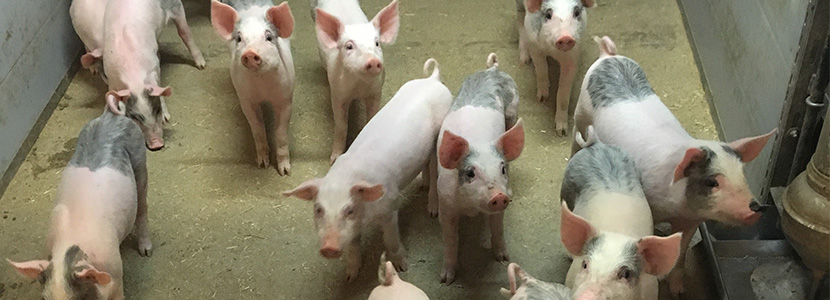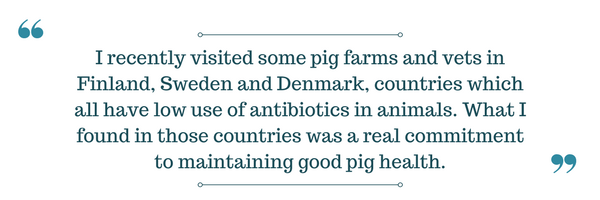Expert Spotlight: Five Questions with Georgina Crayford of UK National Pig Association
We are very impressed with news that the United Kingdom has decreased its antibiotic use in its pork and poultry sectors. Earlier this summer we met Georgina Crayford, a 2017 Nuffield Farming Scholar and Senior Policy Adviser, at the UK National Pig Association. Dr. Crayford is traveling around the world this year to conduct research on antibiotic stewardship best practices, and then she’ll share her first-hand knowledge with the UK farming community. She provided an interesting perspective of what is happening in Europe that we thought you would find interesting too.
1. We met when you came to Washington, DC and you had been on a whirlwind travel schedule to meet with farmers, food companies, policymakers and NGOs around the world to talk about how to achieve real and sustainable reductions in antibiotic use on pig farms. Can you tell us more about your experience?
The Nuffield Farming Scholarships Trust recognises that one of the most effective ways to identify best practice, whatever the topic, is to see how people in other countries are doing things. Hence the Trust awards travel scholarships to people involved in agriculture every year and we Scholars cover a whole range of issues between us. Fortunately during my travels I have found that antibiotic resistance and use of antibiotics in agriculture is a hot topic and discussions about how to use them more responsibly are being held at all levels. This is of course really promising and demonstrates that the issue has successfully been raised to one of global importance. I still have some travelling left to do, including trips to Canada, Australia and a return trip to the United States to meet with pig farmers in Iowa, but already I’ve learnt so much.
2. How has the British pig industry been able to decrease antibiotic use?
I think promoting awareness of the issue has been key. It’s only really been in the last couple of years that we’ve been talking to farmers about the dangers of antibiotic resistance and the impact that antibiotic use in farming has, so for a while they just needed to get their heads around it. That awareness laid the foundations, and then the next big leap forward was the launch of the industry’s electronic medicine book (eMB-Pigs), which farmers can use to upload their farm’s antibiotic use data. Seeing the data there in front of them really highlighted to farmers how much they were using and got them thinking about what they could do to reduce use.
3. In the summer of 2016, the UK livestock industry has entered negotiations with the Government to set new, long-term antibiotic use reduction targets. Can you tell us more about this process?
Yes, after the final report of Lord Jim O’Neill’s Review on AMR was published, the UK Government responded with its plans for how it would achieve the recommendations in the report. This included a requirement that every livestock sector should set species-specific targets for reducing antibiotic use. A Targets Taskforce made up of vets and farmers was set up by the Responsible Use of Medicines in Agriculture Alliance, and their job was to determine what the targets should be. The Government made it clear that they wanted the targets to be challenging, but the fact that the livestock industry was able to decide what the targets should be means there is a sense of ownership and motivation to achieve them which I don’t think would have been the case if the targets had just been thrust upon us by authorities.
4. During your travels, what insights can you provide on how other countries have managed to achieve antibiotic reductions and what others are planning to do?
I recently visited some pig farms and vets in Finland, Sweden and Denmark, countries which all have low use of antibiotics in animals. What I found in those countries was a real commitment to maintaining good pig health. For example, Sweden and Finland have successfully eradicated a number of common pig diseases, such as Salmonella and PRRS virus. In Denmark they have an excellent programme for producing high health breeding pigs and monitoring diseases in herds. Good health, of course, reduces the need to rely on antibiotics.
I have also been talking to social scientists to understand how we might change the behavior of farmers when it comes to using antibiotics. One thing that I learned from those discussions is that everyone, including farmers, prefers to adhere to “social norms.” So behavior change might be achieved by somehow breaking down a bad norm (e.g. giving antibiotics to pigs routinely) and establishing a new one (e.g. only using antibiotics when absolutely necessary). I’m still trying to work how we do that though!
5. Now a more light-hearted question, but what was your favorite part of coming to the U.S?! Any favorite or unfavorite food or tourist experience?!
After my brief visit to Washington DC, I went over to California and was simply wowed by Yosemite Park – such amazing scenery! I was also really surprised by the size of the White House… it’s much smaller in real life compared to how it looks on TV!





